Luminous Mysteries in Stained Glass
Pope St John Paul II introduced a new set of Mysteries of the Rosary, called the Luminous Mysteries, in 2002.
The first Luminous Mystery is the Baptism of the Lord. This window in Sts Peter and Paul, Noubalay, France, shows the scene: against protestations about his unworthiness, John baptised Jesus in the River Jordan.
The Holy Trinity was present at this baptism: God the Father as a voice from Heaven saying “This is My beloved Son in whom I am well pleased,” Jesus being baptised, and the Holy Spirit descending on Jesus in the form of a dove.
Jesus subsequently died on the cross to free me from original sin, and I believe that my baptism as an infant wiped all that historical baggage away and gave me an openness to the Holy Spirit that bore fruit eventually in my adult life.
From another point of view, Jesus‘ baptism marked the start of his public ministry. First, though, He went out into the desert and was tempted by the devil. Our own baptism equipped us to deal with temptation, didn’t it?
Not long after his baptism Jesus and his mother Mary were invited to the Wedding Feast at Cana, the second Mystery. Here Jesus performed His first recorded miracle. This window [2] in St Alban’s, Pléneuf-Val-André, France, shows the scene. The wedding party is in the background, Jesus and Mary are the focus of the scene. A servant is filling a jar with water, with Jesus in the act of blessing it.
The wine had run short, and Mary turned to Jesus. Jesus told her that his time had not yet come and she shouldn’t tell him what to do! She ignored him, as any mother would, and told the servants to do what Jesus told them. They filled six stone jars with water, which Jesus then turned into wine.
The Master of Ceremonies thought the best wine had been kept till last, contrary to the normal practice of using the best wine first. That was presumably on the basis that no-one would care about the quality of the wine later on!
Two things strike me as I think about this event. First, if the quality of the wine is anything to go by, Jesus will always do the best for me. Second, the fact that Mary over-rode Jesus is an indication of how much influence she has on him. That is a very good reason to pray the Rosary and ask Mary to use her influence!
The third Mystery is the Proclamation of the Kingdom of God and the call to conversion. Jesus preached the Kingdom of God to a crowd on many occasions. I like to think this window [3] in First Presbyterian Church, Invercargill, exemplifies the scene. It probably shows the Sermon on the Mount. Jesus is pointing to his Father in heaven. He is surrounded by a crowd with some people in need of healing at his feet. I can almost hear him saying “Happy the poor in spirit, theirs is the Kingdom of Heaven” (Matthew 5:3).
What does it mean to be poor in spirit? The CEV translation puts it as “God blesses those people who depend only on him. They belong to the Kingdom of Heaven.” That is much easier to understand. Putting my faith in God means emptying myself of everything else; and focussing on God alone would leave me poor in spirit, waiting to be filled with God’s riches.
Jesus went on to preach the rest of the Beatitudes. Blessed are the gentle, those who mourn, search for justice, are merciful, pure in heart, peacemakers, or persecuted.
“Rejoice and be glad” He said, “your reward will be great in heaven”. I can’t wait!
The Fourth Luminous Mystery is The Transfiguration. According to Matthew’s Gospel, Jesus took Peter, James and John up a high mountain to pray and Jesus was transfigured before them. His face became as dazzling as the sun, his clothes as radiant as light. Moses and Elijah were talking with Jesus, representing the law and prophets of the Old Testament.
The three disciples didn’t really appreciate what was happening, and Peter offered to make three tents, one each for Jesus, Moses and Elijah. Jesus probably didn’t even hear Peter!
Then God spoke “This is my Son in whom I am well pleased, listen to Him.” Jesus’ full glory was revealed that day. This window [4] from Holy Sepulchre Church, Grafton, Auckland, shows the scene in a very colourful way. Moses with the ten commandments is on the left, Elijah on the right. The three disciples are awestruck at Jesus’ feet – I have no doubt Peter is the one to the left. God’s words and Peter’s are enshrined.
The false note in this portrayal is the lack of luminosity in the figure of Jesus. The partial window below [5] in St Peter’s, Trentham, Wellington was designed by my friend Beverley Shore Bennett. When I asked her why Jesus’ features were so vague, she pointed out that the disciples would have been so dazzled they wouldn’t have seen very much of Jesus anyway. Have you ever been dazzled by Jesus?
The Fifth Luminous Mystery is the Institution of the Eucharist. This happened at the Last Supper, of course. Just before Jesus sacrificed himself for us on the cross, he left us both a reminder of that sacrifice, and spiritual food for our souls.
This window [6] in the Cathedral of St Mary the Crowned, Gibraltar, shows the scene in the upper room very scripturally and colourfully. John is reclining next to Jesus, Judas, the only one without a halo, is about to sneak out. They have not yet eaten, and Jesus is offering up the bread. The chalice is on the table.
At the Offertory, the priest says quietly:
Blessed are you, Lord God of all creation, for through your goodness we have received the bread we offer you: fruit of the earth and work of human hands, it will become for us the bread of life.
Blessed are you, Lord God of all creation, for through your goodness we have received the wine we offer you: fruit of the vine and work of human hands, it will become our spiritual drink.
Pray, brethren (brothers and sisters), that my sacrifice and yours may be acceptable to God, the almighty Father.
To me, these words, fruit of the earth and vine – therefore, gift of God – then worked by human hands, mean that we are active participants with God in the Eucharist, not meant to kneel there passively until Communion time.
What do you think?

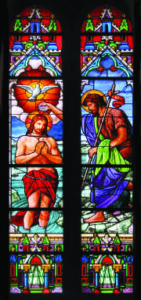
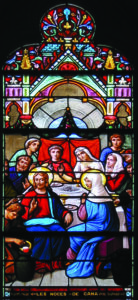
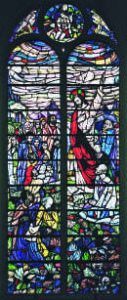
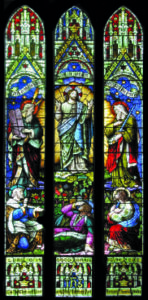
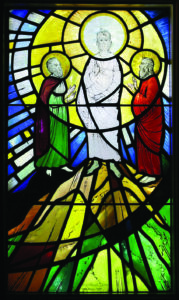
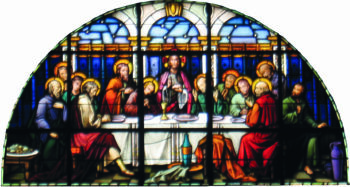
 Entries(RSS)
Entries(RSS)